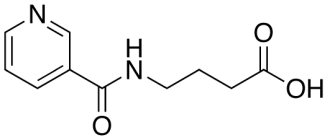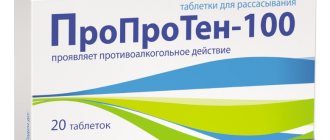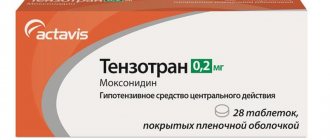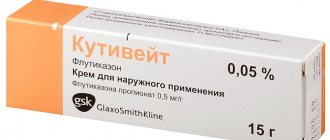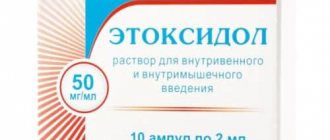The drug Selectra belongs to the group of pharmacological agents that have antidepressant effects.
The effect after starting to take the tablets is observed after 2-4 weeks, but the course of treatment is 3-6 months to consolidate the result.
Release form, composition and packaging
White film-coated tablets, oval, biconvex, engraved “E” on one side, scored on the other side and side scored.
| 1 tab. | |
| escitalopram oxalate | 12.78 mg, |
| which corresponds to the content of escitalopram | 10 mg |
Excipients: prosolv SMCC®90/HD90 - 147.42 mg (microcrystalline cellulose - 144.47 mg, silicon dioxide - 2.95 mg), croscarmellose sodium - 9 mg, talc - 9 mg, magnesium stearate - 1.8 mg.
Film shell composition: opadry white (Opadry 03F28446 White) ~ 5.4 mg: hypromellose 6cP - 3.29 mg, titanium dioxide - 1.31 mg, macrogol 6000 - 0.8 mg.
10 pieces. - blisters (1) - cardboard packs. 14 pcs. - blisters (2) - cardboard packs.
pharmachologic effect
Antidepressant, selective serotonin reuptake inhibitor (SSRI). Inhibition of serotonin reuptake leads to an increase in the concentration of this neurotransmitter in the synaptic cleft, enhancing and prolonging its effect on postsynaptic receptor sites.
Escitalopram has no or very weak ability to bind to a number of receptors, including: serotonin 5-HT1A-, 5-HT2 receptors, dopamine D1 and D2 receptors, α1-, α2-, β-adrenergic receptors, histamine H1 receptors, m-cholinergic receptors, benzodiazepine and opioid receptors.
Pharmacokinetics
Suction and distribution
Absorption is independent of food intake. The bioavailability of escitalopram is about 80%. The average time to reach Cmax in blood plasma is about 4 hours.
The kinetics of escitalopram is linear. Css is achieved in approximately 1 week. The average Css is 50 nmol/l (from 20 to 125 nmol/l) achieved with a daily dose of 10 mg.
After oral administration, the apparent Vd ranges from 12 to 26 l/kg. The binding of escitalopram and its main metabolites to plasma proteins is about 80%.
Metabolism
Escitalopram is metabolized in the liver to demethylated and didemethylated metabolites. They are both pharmacologically active. The main substance and its metabolites are partially released in the form of glucuronides.
After repeated use, the average concentration of demethyl and didemethyl metabolites is usually 28-31% and less than 5%, respectively, of the concentration of escitalopram. Biotransformation of escitalopram into a demethylated metabolite occurs mainly through the cytochrome CYP2C19. Some involvement of CYP3A4 and CYP2D6 isoenzymes is possible. In individuals with weak CYP2C19 activity, the concentration of escitalopram may be twice as high as in cases with high activity of this isoenzyme. No significant changes in the concentration of the drug were found in cases with weak activity of the CYP2D6 isoenzyme.
Removal
T1/2 after repeated use is about 30 hours. Oral clearance is about 0.6 l/min. The main metabolites of escitalopram have a longer T1/2. Escitalopram and its main metabolites are excreted by the liver (metabolic pathway) and kidneys.
Pharmacokinetics in special clinical situations
In elderly patients (over 65 years of age), escitalopram is excreted more slowly than in younger patients. AUC in the elderly is 50% greater than in young healthy volunteers.
Price
The cost of Selectra depends on the manufacturer and the number of tablets in the package ( 461-970 rubles for 28 pieces ).
Price in Moscow – 989 rubles (excluding delivery surcharge when ordering online). You can buy tablets in a pharmacy chain or online store.
The antidepressant is dispensed with a prescription in Latin, which complies with the rules for processing medical documents.
SELECTRA: DOSAGE
The drug is prescribed to adults and children over 15 years of age 1 time/day orally, regardless of food intake.
For depressive disorders, 10 mg is prescribed once a day. Depending on the patient’s individual response, the dose can be increased to a maximum of 20 mg/day.
The antidepressant effect usually develops 2-4 weeks after the start of treatment. After the symptoms of depression disappear, therapy must be continued for at least another 6 months to consolidate the effect.
For panic disorders with/without agoraphobia, a dose of 5 mg/day is recommended during the first week of treatment, which is then increased to 10 mg/day. Depending on the patient’s individual response, the dose can be increased to a maximum of 20 mg/day.
The maximum therapeutic effect is achieved approximately 3 months after the start of treatment. Therapy lasts several months.
Elderly patients (over 65 years of age) are recommended to be given half the usually recommended dose (i.e., only 5 mg/day) and a lower maximum dose (10 mg/day).
For mild to moderate renal failure, no dose adjustment is required. Patients with severe renal failure (creatinine clearance below 30 ml/min) should be prescribed the drug with minimal therapeutic doses, gradually increasing them taking into account the tolerability and effectiveness of the drug.
If liver function is impaired, the recommended initial dose during the first two weeks of treatment is 5 mg/day. Depending on the patient's individual response, the dose may be increased to 10 mg/day.
For patients with weak CYP2C19 isoenzyme activity, the recommended initial dose during the first two weeks of treatment is 5 mg/day. Depending on the patient's individual response, the dose may be increased to 10 mg/day.
When discontinuing treatment with the drug, the dose should be gradually reduced over 1-2 weeks in order to avoid withdrawal symptoms.
Indications for use
Selectra belongs to the category of effective antidepressants. The drug is recommended to be taken to combat various types of depressive disorders and panic attacks. In some cases, psychologists may recommend the parallel use of other medications that are aimed at treating depression and eliminating obsessive thoughts.
Numerous reviews from patients who took Selectra confirm that this medicine helps overcome obsessive-compulsive, generalized and social anxiety disorders. Escitalopram is effective for depressive disorders of any severity.
Overdose
Symptoms: dizziness, tremor, agitation, drowsiness, confusion, seizures, tachycardia, ECG changes (changes in the ST segment, T wave, widening of the QRS complex, prolongation of the QT interval), arrhythmias, respiratory depression, vomiting, rhabdomyolysis, metabolic acidosis, hypokalemia, very rarely - acute renal failure.
Treatment: symptomatic and supportive: gastric lavage, adequate oxygenation. Monitoring the function of the cardiovascular and respiratory systems. There is no specific antidote.
Drug interactions
Serious adverse reactions may occur when taking Selectra and MAO inhibitors simultaneously, as well as when taking MAO inhibitors in patients who have recently stopped taking the drug. In such cases, serotonin syndrome may develop.
Escitalopram should not be administered concomitantly with MAO inhibitors. Escitalopram can be prescribed 14 days after stopping treatment with irreversible MAO inhibitors and at least 1 day after stopping treatment with the reversible MAO type A inhibitor, moclobemide. At least 7 days must pass after stopping escitalopram before treatment with non-selective MAO inhibitors can be started.
Concomitant use with serotonergic drugs (eg, tramadol, sumatriptan and other triptans) may lead to the development of serotonin syndrome.
Selectra may lower the seizure threshold. Caution is required when co-administered with other drugs that lower the seizure threshold (tricyclic antidepressants, other SSRIs, antipsychotics (phenothiazines, thioxanthene and butyrophenone derivatives), mefloquine and tramadol).
Escitalopram enhances the pharmacological effects of tryptophan (increased serotonergic effect) and the toxic effects of lithium preparations.
The simultaneous administration of escitalopram and drugs containing St. John's wort (Hypericum perforatum) may lead to an increase in the number of side effects.
Bleeding disorders may occur when escitalopram is co-administered with oral anticoagulants and other drugs that affect blood clotting (for example, atypical antipsychotics and phenothiazines, most tricyclic antidepressants, acetylsalicylic acid and NSAIDs, ticlopidine and dipyridamole). In such cases, monitoring of blood coagulation parameters is necessary.
Escitalopram does not interact pharmacodynamically or pharmacokinetically with ethanol. However, as with other psychotropic drugs, the simultaneous use of escitalopram and alcohol is not recommended.
Effect of other drugs on the pharmacokinetics of escitalopram
Co-administration with drugs that inhibit CYP2C19 may increase plasma concentrations of escitalopram. Caution should be exercised when escitalopram is used concomitantly with similar drugs, such as omeprazole. A dose reduction of escitalopram may be required.
Caution should be exercised when escitalopram is administered in high doses concomitantly with cimetidine, which is a strong inhibitor of the CYP2D6, CYP3A4 and CYP1A2 isoenzymes, in high doses.
Effect of escitalopram on the pharmacokinetics of other drugs
Escitalopram is an inhibitor of the CYP2D6 isoenzyme. Caution should be exercised when co-prescribing escitalopram and drugs metabolized by this isoenzyme and having a low therapeutic index, for example, flecainide, propafenone and metoprolol (in cases of use in heart failure) or drugs mainly metabolized through CYP2D6 and acting on the central nervous system , for example, antidepressants - desipramine, clomipramine, nortriptyline or antipsychotics - risperidone, thioridazine, haloperidol. In these cases, dose adjustment may be required, because the concentration of escitalopram in the blood plasma increases.
The simultaneous administration of escitalopram and desipramine or metoprolol leads to a twofold increase in the concentration of the latter two drugs, which should be taken into account when choosing doses.
Escitalopram may slightly inhibit the CYP2C19 isoenzyme. Therefore, caution is recommended when using escitalopram concomitantly with medicinal products metabolized by CYP2C19.
SELECTRA: SIDE EFFECTS
Side effects most often occur at 1 or 2 weeks of treatment, then usually become less intense and occur less frequently as therapy is continued.
From the central nervous system: dizziness, weakness, insomnia or drowsiness, convulsions, tremor, movement disorders, serotonin syndrome (agitation, tremor, myoclonus, hyperthermia), hallucinations, manic disorders, confusion, agitation, anxiety, depersonalization, panic attacks, increased irritability , visual disturbances.
From the digestive system: nausea, vomiting, dry mouth, taste disturbances, loss of appetite, diarrhea, constipation.
From the cardiovascular system: orthostatic hypotension.
From the endocrine system: decreased secretion of ADH, galactorrhea.
From the genitourinary system: decreased libido, impotence, impaired ejaculation, anorgasmia (in women), urinary retention.
Dermatological reactions: skin rash, itching, ecchymosis, purpura.
Allergic reactions: angioedema, anaphylactic reactions.
From laboratory parameters: hyponatremia, changes in laboratory parameters of liver function.
Other: increased sweating, hyperthermia, sinusitis, arthralgia, myalgia.
In addition, after long-term use, abrupt cessation of therapy with Selectra may lead to withdrawal syndrome in some patients. If you abruptly stop taking escitalopram, undesirable reactions such as dizziness, headaches and nausea may occur, the severity of which is insignificant and the duration is limited.
Reviews from patients who took the drug
Tatyana Vladimirovna, 52 years old:
Doctors diagnosed me with panic attacks. At the initial stage of therapy, the state was terrible: apathy towards everything that was happening, children, grandchildren. Sharp changes in mood, unreasonable irritability and insomnia began to tire me and my loved ones with whom I live under the same roof. After the first month of taking Selectra, life began to take on some colors and make me happy with simple things - good weather, new purchases.
The impressive list of side effects passed me by.
Vitaly, 27 years old:
After the accident, he could not come to his senses for a long time until he fell into a depressive state. I went to the clinic to see a neurologist because of insomnia. The doctor referred me to a psychotherapist, who prescribed Selectra. The first days after starting the course of treatment were difficult, headaches appeared, bowel movements were disrupted, and potency decreased. But by the third week the condition stabilized, and no more side effects appeared. Sex life improved after the end of therapy.
Olga, 34 years old:
A month after taking the antidepressant, Selectra felt easier to perceive everything that was happening. Anxiety and irritability disappeared as if by hand. The doctor did not discontinue the drug after the condition improved; he recommended taking the pill for another couple of months to consolidate the effect.
I’ve been living a normal life for a year and a half now, enjoying every moment, and there have been no relapses.
Contraindications
- simultaneous use with MAO inhibitors;
- children's age (up to 15 years);
- pregnancy;
- lactation period (breastfeeding);
- hypersensitivity to the drug or its components.
The drug should be prescribed with caution in renal failure (creatinine clearance below 30 ml/min), hypomania, manic disorders, pharmacologically uncontrolled epilepsy, depression with suicidal attempts, diabetes mellitus, liver cirrhosis, bleeding tendency, when taken simultaneously with drugs that lower the threshold convulsive readiness causing hyponatremia, with ethanol, with drugs metabolized by CYP2C19, as well as in elderly patients and adolescents aged 15 to 18 years.
Analogs
If there are contraindications, the antidepressant should be replaced with another drug. Before buying a medicine to combat depressive disorders, you need to study the instructions and consult with a psychologist.
| Drug name | Description |
| Deprefault | The drug is intended for the treatment and prevention of relapse of major depressive episode, generalized anxiety disorder, social phobia, and post-traumatic stress syndrome. The drug is contraindicated during pregnancy and lactation, in childhood (up to 6 years), as well as in unstable epilepsy and increased sensitivity of the body to its constituent components. The initial dose of antidepressant should not exceed 25 mg per day. After 7 days, the dosage begins to be increased by 50 mg once a week. The maximum dose is 200 mg/day. The duration of treatment depends on the patient's condition. |
| Actaparoxetine | Psychologists prescribe this drug to treat all types of depression, obsessive-compulsive disorder and panic attacks. Actaparoxetine helps cope with social phobia, post-traumatic stress, and generalized anxiety disorders. Contraindications: children (under 18 years of age), pregnancy and lactation, hypersensitivity to the components of the drug. The standard dosage of the drug is 20 mg/day. In the absence of a positive therapeutic effect, the dose can be gradually increased by 10 mg. The maximum dosage is 50 mg. You need to take Actaparoxetine for at least 4-6 months. |
| Fluoxetine | This medication is recommended for the treatment of depression, obsessive-compulsive disorder and bulimic neuroses. The drug is prohibited for use by patients who have been diagnosed with the following diseases: epilepsy, bladder atony, liver or kidney failure, glaucoma, prostate adenoma. It is recommended to take the medicine once a day immediately after waking up, 20 mg. The duration of treatment is determined individually. |
| Adepress | This drug helps to overcome anorexia nervosa and bulimia, depression, obsessive thoughts, bipolar affective and post-traumatic stress disorders, and social phobia. Adepress is not recommended for use in cases of unstable epilepsy, increased sensitivity of the body to the components of the drug, as well as during pregnancy and breastfeeding. The treatment regimen is selected on an individual basis, but the maximum daily dosage of the drug should not exceed 60 mg (for patients over 65 years old - 40 mg). Treatment should last at least 4-6 months. |
| Rexetine | Indications for use of the drug: organic lesions of the central nervous system, episodes of bipolar disorder, depression of various etiological origins, treatment and prevention of obsessive-compulsive disorder. Rexetine is not prescribed to patients who have been diagnosed with the following diseases and conditions: prostatic hyperplasia, long QT syndrome, arrhythmia, closed angle glaucoma, liver failure. You need to take the drug 10-20 mg once a day. The maximum dosage is 50 mg per day. The standard therapeutic course lasts 4-6 months. |
Provided that the drug is chosen correctly and all the recommendations of the psychologist are followed, after undergoing long-term drug therapy, the patient will be able to return to a full life, significantly improving his psycho-emotional state.
special instructions
Some patients with panic disorder may experience increased anxiety when starting SSRI treatment. This paradoxical reaction usually disappears within two weeks of treatment. To reduce the likelihood of an anxiogenic effect, it is recommended to use the drug in a low initial dose.
The drug should be discontinued if seizures develop. Use in patients with uncontrolled epilepsy is not recommended; Controlled seizures require careful monitoring. If the frequency of seizures increases, SSRIs, including escitalopram, should be discontinued.
Escitalopram should be used with caution in patients with a history of mania/hypomania. If a manic state develops, escitalopram should be discontinued.
In patients with diabetes mellitus, treatment with escitalopram may change blood glucose levels (both hypoglycemia and hyperglycemia are possible). Therefore, dose adjustments of insulin and/or oral hypoglycemic agents may be necessary.
The risk of committing suicide is inherent in depression and may persist until the condition significantly improves, either spontaneously or as a result of therapy. Careful monitoring of patients being treated with antidepressants is necessary, especially at the beginning of treatment, due to the possibility of clinical deterioration and/or the emergence of suicidal manifestations (thoughts and behavior). This precaution should also be observed when treating other mental disorders due to the possibility of simultaneous development of depression.
In some cases, when treated with SSRI antidepressants, there was an increased risk of developing suicidal thoughts and behavior in children, adolescents and young adults under 24 years of age, compared to placebo.
Hyponatremia, possibly associated with impaired ADH secretion, occurs rarely with escitalopram and usually disappears when therapy is discontinued. Caution should be exercised when prescribing escitalopram and other SSRIs to persons at risk of developing hyponatremia: the elderly, those with liver cirrhosis, and those taking medications that can cause hyponatremia.
When taking escitalopram, subcutaneous hemorrhages (ecchymosis and purpura) may develop. Escitalopram should be used with caution in patients with a tendency to bleed, as well as those taking oral anticoagulants and other drugs that affect blood clotting.
Since clinical experience with the simultaneous use of escitalopram and electroconvulsive therapy is limited, caution should be exercised in such cases.
The combination of escitalopram and MAO type A inhibitors is not recommended due to the risk of developing serotonin syndrome.
In rare cases, patients taking escitalopram and other SSRIs concomitantly with serotonergic drugs may develop serotonin syndrome. Escitalopram should be used with caution concomitantly with drugs that have serotonergic effects. A combination of symptoms such as agitation, tremor, myoclonus, and hyperthermia may indicate the development of serotonin syndrome. If this occurs, SSRIs and serotonergic drugs should be immediately discontinued and symptomatic treatment prescribed.
Impact on the ability to drive vehicles and operate machinery
During treatment with the drug, patients should avoid performing potentially hazardous activities that require high speed psychomotor reactions, such as driving a car or operating machinery.
Reviews from doctors
Alexander Mikhailovich, psychotherapist with 22 years of experience:
I have been using the drug Selectra in my practice for several years. The antidepressant is well tolerated by patients of different age groups, despite concomitant symptoms: diabetes mellitus, hypotension, cardiovascular diseases. A pronounced effect is observed after 2-3 weeks of taking the tablets.
An important positive factor is the availability of the medicine - reasonable price, no problems with purchase.
Yulia Nikolaevna, psychiatrist with 16 years of experience:
Selectra is a typical analogue of another drug - Cipralex, which is also developed on the basis of escitalopram. It differs from the original at an affordable price, but the effect remains high. In comparison with other drugs included in the same group, it is better tolerated by patients and has a minimal percentage of side effects.
The achieved result is maintained after a course of treatment. The low toxicity of the composition practically eliminates the possibility of poisoning from tablets if the dosage is exceeded. The drug is used in practice not only by psychiatrists, but also by neurologists and other general practitioners in medicine.
